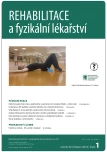-
Medical journals
- Career
Physiotherapy in primary and lower-secondary school children with poor posture
Authors: Černický M.; Oravcová P.; Kocúrová K.
Authors‘ workplace: Fakulta zdravotníctva, Trenčianska univerzita Alexandra Dubčeka v Trenčíne, Trenčín, Slovenská republika
Published in: Rehabil. fyz. Lék., 30, 2023, No. 1, pp. 13-17.
Category: Original Papers
doi: https://doi.org/10.48095/ccrhfl202313Overview
Background: Poor posture is a civilizational disease that is increasingly affecting our child population. Thanks to correct and timely diagnosis and treatment, it is possible to eliminate this disorder. Methodology: Our work was carried out through quantitative research by means of a non-standardized questionnaire, which was anonymous and focused on the methods used in the diagnosis of faulty posture. It contained 17 open, semi-open and closed questions. Totally, three hypotheses were determined, which we verified using the SPSS Statistics 26 program and the chi-square test. Sample: The sample consisted of 200 respondents, physiotherapists from Trenčiaské and Žilina Regions, whom we mutually compared. The selection of the sample was not random, the respondents had to encounter the diagnosis of incorrect posture in children aged 6 to 15 years during their practice. Results: Based on the statistical results, the use of the Spiraldynamik concept was confirmed, which is applied by more physiotherapists from the Žilina Region than from the Trenčín Region (P < 0.001). Furthermore, we statistically confirmed that physiotherapists in the Trenčín Region do not apply the Feldenkrais method as often as physiotherapists in the Žilina Region (P < 0.027). It was not statistically confirmed that acral co-activation therapy is known to significantly fewer physiotherapists in the Žilina Region than in the Trenčín Region (P > 0.184). Conclusion: In order to eliminate the occurrence of poor posture in adulthood, we must maintain and promote correct posture as early as in childhood. Kinesiotherapy must contain precise procedures and methods for adopting preventive measures and supporting correct movement stereotypes.
Keywords:
prevention – Physiotherapy – posture – school age – bad posture
Sources
1. Hošková B et al. Vademecum. Zdravotní tělesná výchova (druhy oslabení). Praha: Karolinum 2012. ISBN 978-80-246-2137-1.
2. Levitová A, Hošková B. Zdravotně-kompenzační cvičení. Praha: Grada Publishing 2016. ISBN 978-80-271-9044-7.
3. Bursová M. Kompenzační cvičení. Praha: Grada Publishing 2005. ISBN 80-247-0948-1.
4. Dalise S, Azzollini V, Chisari C. Brain and muscle: how central nervous system disorders can modify the skeletal muscle. Diagnostics 2020; 10(12): 1047. doi: 10.3390/diagnostics10121047.
5. Fárová H, Filipová V, Kratěnová J. Cvičení pro děti při vadném držení těla. SZÚ 2003. [online]. Dostupné z: http://www.szu.cz/uploads/documents/chzp/zdrav_stav/cviceni_deti.pdf.
6. Gránska A. Fyzioterapeut o vývine detí: zlé držanie tela a podobné zlozvyky často začínajú už v škôlke. EduWorld.sk 2020. [online]. Dostupné z: https://eduworld.sk/cd/zuzana-granska/3553/fyzioterapeut-csaba-csolti-o-vyvine-deti-zle-drzanie-tela-zacina-v-skolke.
7. Colquitt JL, Loveman E, O’Malley C et al. Diet, physical activity, and behavioral intervention for the treatment of overweight or obesity in preschool children up to the age of 6 years. Cochrane D Syst Rev 2016; 3: CD012105. doi: 10.1002/14651858.CD012105.
8. Korakakis V, O’Sullivan K, O’Sullivan PB et al. Physiotherapist perceptions of optimal sitting and standing posture. Musculoskelet Sci Pract 2019; 39 : 24–31. doi: 10.1016/j.msksp.2018.11.004.
9. Quka N, Stratoberdha D, Selenica R. Risk factors of poor posture in children and its prevalence. Acad J Interdiscip Stud 2015; 3(4). [on-line]. Available from: https://www.mcser.org/journal/index.php/ajis/article/view/8166.
10. Straker L, Campbell A, Coenen P et al. Movement, posture and muscle activity in young children using tablet computers. Amsterodam UMC 2015. [online]. Available from: http://www.iea.cc/congress/2015/1899.pdf.
11. Kurzeja P, Gąsienica-Walczak B, Ogrodzka-Ciechanowicz K et al. Analysis of the ability to tolerate body balance disturbance in relation to selected changes in the sagittal plane of the spine in early school-age children. J Clin Med 2022; 11(6): 1653. doi: 10.3390/jcm11061653.
12. Filho NM, Coutinho ES, Silva A. Association between home posture habits and low back pain in high shool adolescents. Eur Spine J 2015; 24(3): 425–433. doi: 10.1007/s00586-014-3571-9.
13. Minghelli B, Nunes C, Oliveira R. Effectiveness of a back school and postural education program on the improvement of literacy about postures and low back pain in adolescents: a 1-year follow-up study. J. Orthop Sci 2021; 26(4): 543–547. doi: 10.1016/j.jos.2020.05.014.
Labels
Physiotherapist, university degree Rehabilitation Sports medicine
Article was published inRehabilitation & Physical Medicine

2023 Issue 1-
All articles in this issue
- Hand function and handwriting treatment program in post-stroke patients – a pilot study
- Physiotherapy in primary and lower-secondary school children with poor posture
- Relationship between diastasis recti abdominis and back pain in postpartum women
- Analysis of the preferred writing tool grip in Czech university students
- The effect of physiotherapy on the quality of motion patterns in impingement syndrome
- Development of rehabilitation in the Czech Republic
- The Franklin Method – body and movement in imagination
- Rehabilitation & Physical Medicine
- Journal archive
- Current issue
- Online only
- About the journal
Most read in this issue- Development of rehabilitation in the Czech Republic
- Physiotherapy in primary and lower-secondary school children with poor posture
- The Franklin Method – body and movement in imagination
- The effect of physiotherapy on the quality of motion patterns in impingement syndrome
Login#ADS_BOTTOM_SCRIPTS#Forgotten passwordEnter the email address that you registered with. We will send you instructions on how to set a new password.
- Career

